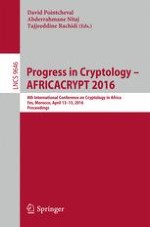This book constitutes the thoroughly refereed proceedings of the 8th International Conference on the Theory and Application of Cryptographic Techniques in Africa, AFRICACRYPT 2016, held in Fes, Morooco, in April 2016.
The 18 papers presented in this book were carefully reviewed and selected from 65 submissions. The aim of Africacrypt 2016 is to provide an international forum for practitioners and researchers from industry, academia and government from all over the world for a wide ranging discussion of all forms of cryptography. Topics of interest are such as lattices; elliptic curves; secret-key cryptanalysis; efficient implementations; secure protocols; and public-key cryptography.
